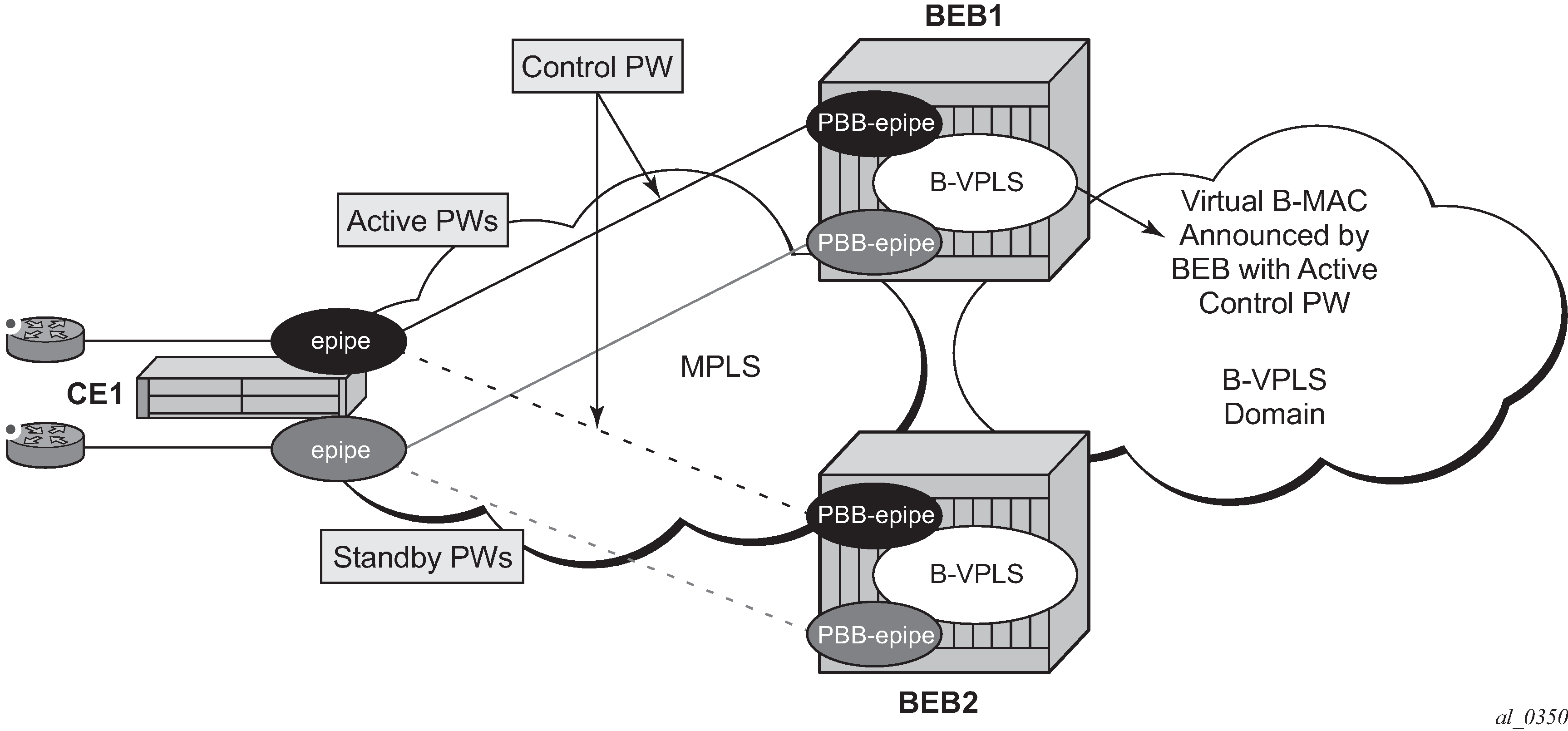It is possible to connect backbone edge bridges (BEBs) configured with PBB Epipes to an edge device using active/standby pseudowires over an MPLS network. This is shown in Figure 1.

In this topology, the edge device (CE1) is configured with multiple Epipes to provide virtual lease line (VLL) connectivity across a PBB network. CE1 uses active/standby pseudowires (PWs) which terminate in PBB Epipe services on BEB1 and BEB2 and are signaled accordingly using the appropriate pseudowire status bits.
Traffic is sent from CE1 on the active pseudowires into the PBB Epipe services, then onto the remote devices through the B-VPLS service. It is important that traffic sent to CE1 is directed to the BEB that is attached to the active pseudowire connected to CE1. To achieve this, a virtual backbone MAC (vB-MAC) is associated with the services on CE1.
The vB-MAC is announced into the PBB core by the BEB connected to the active pseudowire using SPBM configured in the B-VPLS services; therefore, SPBM is mandatory. In Figure 1, the vB-MAC would be announced by BEB1; if the pseudowires failed over to BEB2, BEB1 would stop announcing the vB-MAC and BEB2 starts announcing it.
The remote services are configured to use the vB-MAC as the backbone destination MAC (backbone-dest-mac) which results in traffic being sent to the specified BEB.
The vB-MAC is configured under the SDP used to connect to the edge device’s active/standby pseudowires using the command source-bmac-lsb. This command defines a sixteen (16) bit value which overrides the sixteen least-significant-bits of source backbone MAC (source-bmac) to create the vB-MAC. The operator must ensure that the vB-MACs match on the two peering BEBs for a corresponding SDP.
The PBB Epipe pseudowires are identified to be connected to an edge device active/standby pseudowire using the spoke-sdp parameter use-sdp-bmac. Enabling this parameter causes traffic forwarded from this spoke-SDP into the B-VPLS domain to use the vB-MAC as its source MAC address when both this, and the control pseudowire, are in the active state on this BEB.
PBB Epipe pseudowires connected to edge device’s non-active/standby pseudowires are still able to use the same SDP.
To cater for the case where there are multiple edge device active/standby pseudowires using a specified SDP, one pseudowire must be identified to be the control pseudowire (using the source-bmac-lsb parameter control-pw-vc-id). The state of the control pseudowire determines the announcing of the vB-MAC by SPBM into the B-VPLS based on the following conditions:
The source-bmac-lsb and control-pw-vc-id have both been configured.
The spoke-SDP referenced by the control-pw-vc-id has use-sdp-bmac configured.
The spoke-SDP referenced by the control-pw-vc-id is operationally up and the ‟Peer Pw Bits” do not include pwFwdingStandby.
If multiple B-VPLS services are used with different SPBM Forward IDs (FIDs), the vB-MAC is advertised into any FID which has a PBB Epipe with a spoke-SDP configured with use-sdp-bmac that is using an SDP with source-bmac-lsb configured (regardless of whether the PBB Epipe spoke-SDP defined as the control pseudowire is associated with the B-VPLS).
It is expected that pseudowires configured using an SDP with source-bmac-lsb and with the parameter use-sdp-bmac are in the same state (up, down, active, standby) as the control pseudowire. If this is not the case, the following scenarios are possible (based on Figure 1):
If any non-control pseuodwires are active on BEB2 and standby on BEB1, then this continues to allow bidirectional traffic for the related services as the return traffic to CE1 is sent to BEB1, specifically to the BEB announcing the vB-MAC. As the non-control PW is in standby state it is used to send this traffic to the edge device. If this operation is not needed, it is possible to prevent traffic being sent on a standby PW using the standby-signaling-slave parameter under the spoke-SDP definition.
If any non-control pseudowires are active on BEB2 but down on BEB1, then only unidirectional traffic is possible. The return traffic to CE1 is sent to BEB1, as it is announcing the vB-MAC but the pseudowire on BEB1 is down for this service.
Alarms are raised to track if, on the BEB with the control pseudowire in the standby/down state, any non-control pseudowires go active. Specifically, there is an alarm when the first non-control pseudowire becomes active and another alarm when the last non-control pseudowire becomes standby/down.
If both control pseudowires are active (neither in standby) then both BEBs would announce the vB-MAC – this would happen if the edge device was a 7450 ESS, 7750 SR, and 7950 XRS using an Epipe service without standby-signaling-master configured. Traffic from remote BEBs on any service related to the vB-MAC would be sent to the nearest SPBM BEB and it would depend on the state of the pseudowires on each BEB as to whether it could reach the edge device. Similarly, the operator must ensure that the corresponding service pseudowires on each BEB are configured as the control pseudowire, otherwise SPBM may advertise the vB-MAC from both BEBs resulting in the same consequences.
All traffic received from the edge device on a pseudowire into a PBB Epipe, on the BEB with the active control pseudowire, is forwarded by the B-VPLS using the vB-MAC as the source backbone MAC, otherwise the source-bmac is used.
The control pseudowire can be changed dynamically without shutting down the spoke-SDPs, SDP or withdrawing the SPBM advertisement of the vB-MAC; this allows a graceful change of the control pseudowire. Clearly, any change should be performed on both BEBs as closely in time as possible to avoid an asymmetric configuration, ensuring that the new control pseudowire is in the same state as the current control pseudowire on both BEBs during the change.
The following are not supported:
Active/standby pseudowires within the PBB Epipe are not supported, consequently the following are not supported:
The configuration of endpoints.
The configuration of precedence under the spoke-SDP.
The use of PW switching.
BGP-MH support, namely configuring the pseuodwires to be part of a multihomed site.
Network-domains.
Support for the following tunneling technologies
RFC 3107
GRE
L2TPv3